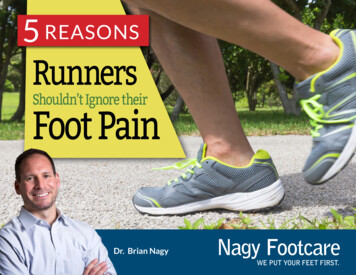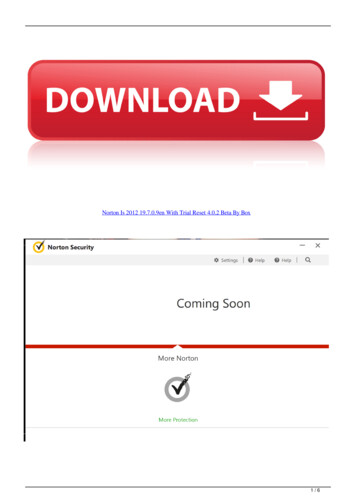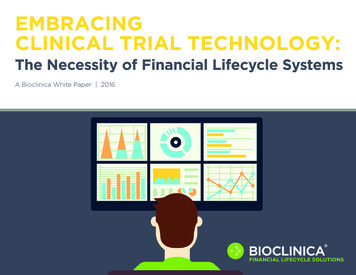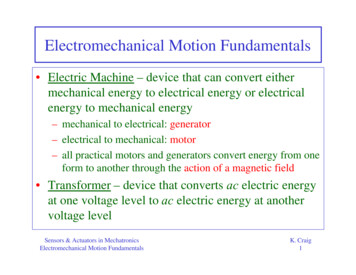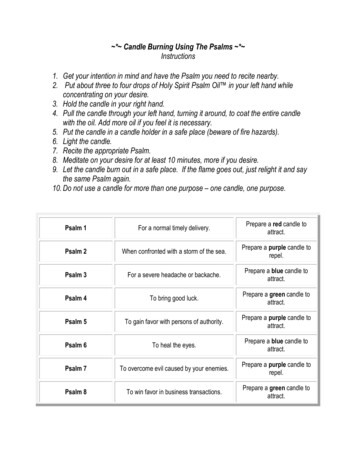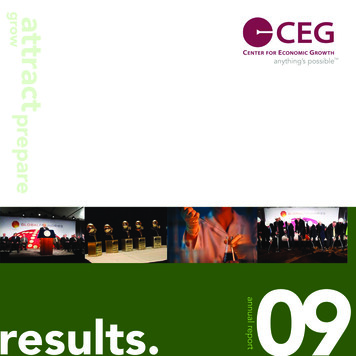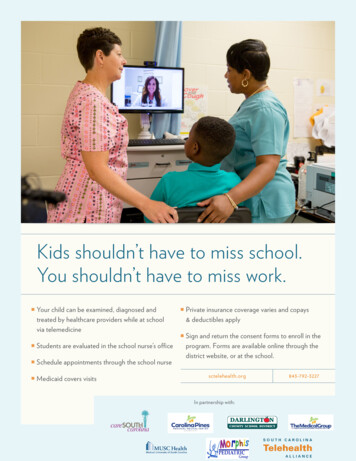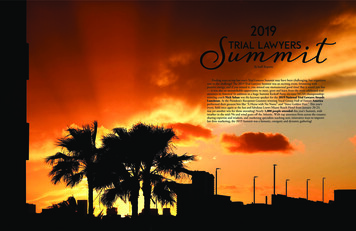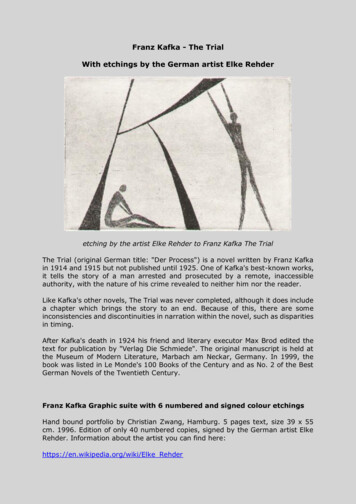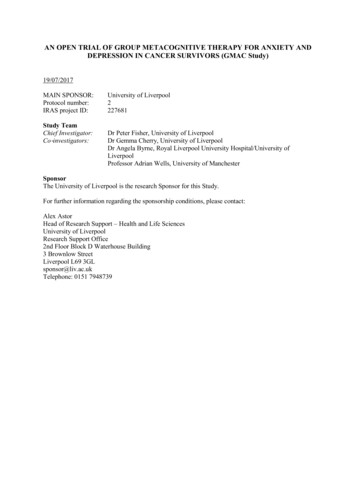
Transcription
162Three HIPAAviolation cases tolearn from.Dr. Sheahan on"the shadowcurriculum."10 News From SVSBe sure to get your ticketsnow for the special gala atthe Vascular Annual Meeting.VOL. 15 NO. 3 MARCH 2019AntibioticCause ofAortopathyExploredAnew study finds that patientstaking fluoroquinolone antibiotics may be at higher risk ofaortopathy in part because of humanaortic myofibroblast–mediated extracellular matrix (ECM) dysregulation.“Emerging evidence supports pharmacologic-associated aortopathy inpatients receiving fluoroquinolone[FQ] antibiotics,” said first authorDavid G. Guzzardi, PhD, and hiscolleagues, citing previous researchshowing that, “compared with patients receiving amoxicillin antibiotics, those receiving FQ have a 66%higher risk of aneurysm or dissectionwithin a 2-month period after commencing FQ use.”See Antibiotic · page 6ATTRACT TrialShouldn’t Detract FromPharmacomechanicalThrombolysisBY BRUCE JANCINMDEDGE NEWSCHICAGO – A closer look at the landmark ATTRACTtrial of pharmacomechanical catheter-directed thrombolysis for acute deep vein thrombosis (DVT) shows multiplebenefits for the intervention versus standard anticoagulation alone in the subset of participants with iliofemoralDVT, Kush R. Desai, MD, said at a symposium on vascular surgery sponsored by Northwestern University.ATTRACT, a National Institutes of Health–sponsored,NEWSBriefsB ruce J ancin /MDeDge newsBY MARK S. LESNEYMDEDGE NEWSFROM THE J O UR N A L O F THO R A CICAND CARDIO VA SCUL A R SUR G E RYDr. Kush R. Desaiphase 3, multicenter, open-label, assessor-blinded study,was the first-ever randomized trial of pharmacomechanical catheter-directed thrombolysis (PCDT) for acute DVT.The results caused a major stir because, despite asound therapeutic rationale for the procedure, the incidence of chronic postthrombotic syndrome (PTS) at 24months of follow-up was 47% in the PCDT plus anticoagulation group and 48% in controls on anticoagulationalone (N Engl J Med. 2017 Dec 7;377[23]:2240-52).Since then, that overall negative trial has been oneSee ATTRACT · page 8Society for Vascular Surgery RelocatesThe new SVS headquarters is located at 9400 W.Higgins Road, Rosemont, Ill. The new building isonly 10 minutes from the Chicago’s O’Hare International Airport and will allow members to easilydrop in and work with staff or hold council andcommittee meetings.News Briefs continued on page 3Vascular specialist10255 W Higgins Road,Suite 280Rosemont, IL 60018CHANGE SERVICE REQUESTEDPresorted StandardU.S. PostagePAIDPermit No. 384Lebanon Jct. KY
FROM THE EDITORThe Shadow Curriculum of U.S. Medical SchoolsBY MALACHI G. SHEAHAN III, MDMEDICAL EDITOR, VASCULAR SPECIALISTSpend a morning in my clinic and it becomesclear that many U.S. medical schools have noformal training in vascular disease. Certainlythe symptoms of PAD are never taught; otherwise,why am I being referred so many patients withspinal stenosis? Some days I would have more usefor an MRI than for my vascular lab. Then again,reviewing the aftermath of patients “treated” byother specialties, maybe some are better off goingundiagnosed.What I believe is needed is a longitudinalmedical school curriculum in peripheral vascular disease. From the basic sciences to theclinical clerkships, a comprehensive educationis essential. Undoubtedly vascular surgeons canprovide this, but first we must understand theroadblocks to curriculum change, and they aresignificant.In the early 1900s, Abraham Flexner was commissioned by the Carnegie Foundation to surveythe quality of North American medical schools.During his travels, Flexner visited 155 schools andfound that many had little staffing, no research,and poor or absent clinical facilities. A number ofschools were simply money-making enterpriseswith dubious educational content. Flexner pulledfew punches in his descriptions, calling some institutions “indescribably foul” and “the plague spotof the nation.” He published his findings in theFlexner Reports of 1910 and 1912.These documents shaped modern medical education in the U.S. Flexner urged schools to adoptnew standards of curriculum, including a modeldividing the 4 years of school into 2 years of basicVASCULAR SPECIALIST Medical Editor Malachi Sheahan III, MDAssociate Medical Editors Bernadette Aulivola, MD, O. WilliamBrown, MD, Elliot L. Chaikof, MD, PhD, Carlo Dall’Olmo, MD, AlanM. Dietzek, MD, RPVI, FACS, Professor Hans-Henning Eckstein, MD,John F. Eidt, MD, Robert Fitridge, MD, Dennis R. Gable, MD, LindaHarris, MD, Krishna Jain, MD, Larry Kraiss, MD, Joann Lohr, MD,James McKinsey, MD, Joseph Mills, MD, Erica L. Mitchell, MD, MEd,FACS, Leila Mureebe, MD, Frank Pomposelli, MD, David Rigberg,MD, Clifford Sales, MD, Bhagwan Satiani, MD., Larry Scher, MD,Marc Schermerhorn, MD, Murray L. Shames, MD, Niten Singh, MD,Frank J. Veith, MD, Robert Eugene Zierler, MDResident/Fellow Editor Laura Drudi, MD.Executive Director SVS Kenneth M. Slaw, PhD.Interim Director of Membership, Marketing and CommunicationsAngela TaylorManaging Editor SVS Beth BalesVascular Specialist is the official newspaper of the Society for VascularSurgery and provides the vascular specialist with timely and relevantnews and commentary about clinical developments and aboutthe impact of health care policy. Content for Vascular Specialist isprovided by Frontline Medical Communications Inc. Content forthe News From the Society is provided by the Society for VascularSurgery.The ideas and opinions expressed in Vascular Specialist donot necessarily reflect those of the Society or the Publisher.The Society for Vascular Surgery and Frontline MedicalCommunications Inc. will not assume responsibility for damages,loss, or claims of any kind arising from or related to theinformation contained in this publication, including any claimsrelated to the products, drugs, or services mentioned herein.2 VASCULAR SPECIALISTDr. Sheahan is theClaude C. CraigheadJr., Professor and Chair,Division of Vascular andEndovascular Surgery,Louisiana State University Health Sciences Center, New Orleansscience and 2 years of clinical experience.In the wake of the Flexner Reports, half ofU.S. medical schools were forced to merge orclose. Still, a standardized system for accreditation was lacking. In 1942, the American Medical Association (AMA) and the Association ofAmerican Medical Colleges (AAMC) establishedthe Liaison Commission for Medical Education(LCME) to meet this goal. Today the LCMEprovides accreditation for U.S. medical schoolsthrough an 8-year review cycle.The LCME defines core curriculum as “therequired components of a medical curriculum,including all required courses/modules and clinicalclerkships/rotations.”1 Reviewing the LCME documents, one finds the specifications for curricularcontent are amazingly vague and astonishinglybrief. Terms like “biochemistry,” “anatomy,” oreven “surgery” are not mentioned.Per LCME standards, it is the faculty of a medical school who define the competencies to beachieved by the students. The curriculum is thenessentially reverse engineered to achieve thesecompetencies. So while the SVS could attempt toopen a discussion with the LCME regarding vas-POSTMASTER Send changes of address (with old mailing label) toVascular Specialist, Subscription Services, 10255 W Higgins Road,Suite 280, Rosemont, IL 60018-9914.RECIPIENT: To change your address, contact Subscription Servicesat 1-800-430-5450. For paid subscriptions, single issue purchases,and missing issue claims, call Customer Service at 1-833-836-2705or e-mail custsvc.vasc@fulcoinc.com.The Society for Vascular Surgery headquarters is located at9400 W. Higgins Road, Suite 315, Rosemont, IL 60018.Vascular Specialist (ISSN 1558-0148) is published monthly for theSociety for Vascular Surgery by Frontline Medical CommunicationsInc., 7 Century Drive, Suite 302, Parsippany, NJ 07054-4609.Phone 973-206-3434, fax 973-206-9378Subscription price is 230.00 per year.National Account Manager Valerie Bednarz, 973-206-8954,cell 973-907-0230, vbednarz@mdedge.comDigital Account Manager Amanda Smith, (973) 206-2321,asmith@mdedge.comClassified Sales Representative Drew Endy, 215-657-2319,cell 267-481-0133, dendy@mdedge.comSenior Director of Classified Sales Tim LePella, 484-921-5001,cell 610-506-3474, tlapella@mdedge.comAdvertising Offices 7 Century Drive, Suite 302, Parsippany, NJ07054-4609 973-206-3434, fax 973-206-9378 Copyright 2019, by the Society for Vascular SurgeryScan this QR Code to visitvascularspecialistonline.comcular education, it appears change must happen atthe individual school level.The good news is that US medical school curricula are now exceptionally fluid. According to the2017-2018 AAMC survey,2 85% of schools reporta significant curriculum transformation withinthe past 3 years. Flipped classrooms, longitudinalcourses, standardized patients, and team-basedlearning have become standard methods of medicalteaching. The most common change reported isthe enhanced integration of basic science contentinto organ system/case-based curriculum (97/147schools). Pass/fail grading standards in basic sciencecourses have also been widely adopted to encourage team learning. Those of us who review studentapplications to residency programs can vouch forthe prevalence and extent of these changes. Manydean’s letters now border on the absurd:Dear Program Director,At the Medical College of the Everglades, we feel ourstudents achieve a broad range of outcomes. Thereforewe assign grades on an unintelligible scale of color hues.In that light, we are pleased to recommend Josh Atkins,MD, as a LEMON DROP YELLOW candidate for yourresidency.Plainly we are evolving from the Flexner systemwhich required 2 years of basic science classwork.This traditional medical education forced a dividebetween the basic sciences and their clinical relevance. Students were asked to memorize facts outof context as passive learners. Then, in the clerkships, would the truths of the Kreb’s cycle magicallyappear through the wonders of ENT clinic? Notlikely. Recently I opened my biochemistry textbookfor the first time since medical school (honestly,FRONTLINE MEDICAL COMMUNICATIONS SOCIETY PARTNERSDirector, FMC Society Partners Mark BrancaEditor in Chief Mary Jo M. DalesExecutive Editors Denise Fulton, Kathy ScarbeckManaging Editor Mark S. LesneyCreative Director Louise A. KoenigDirector, Production/Manufacturing Rebecca SlebodnikLetters to the Editor: VascularSpecialist@vascularsociety.orgEditorial Offices: 2275 Research Blvd, Suite 400, Rockville, MD 20850, 240221-2400, fax 240-221-2548FRONTLINE MEDICAL COMMUNICATIONSCorporatePresident/CEO Alan J. ImhoffCFO Douglas E. GroseSVP, Finance Steven J. ResnickVP, Operations Jim ChiccaVP, Sales Mike GuireVP, Society Partners Mark BrancaVP, Editor in Chief Mary Jo M. DalesVP, Editorial Director, Clinical ContentKaren ClemmentsChief Digital Officer Lee SchweizerVP, Digital Content & Strategy Amy PfeifferPresident, Custom Solutions JoAnn WahlVP, Custom Solutions Wendy RaupersVP, Marketing & Customer AdvocacyJim McDonoughVP, Human Resources & Facility OperationsCarolyn CaccavelliData Management Director Mike FritzCirculation Director Jared SonnersCorporate Director, Research & Comms.Lori RaskinDirector, Custom Programs Patrick FinneganIn affiliation with Global Academy for MedicalEducation, LLCPresident David J. Small, MBAMARCH 2019
I don’t think I opened it too manytimes there). I thumbed through theprelude, which distressingly discussesthe new (!) technology of recombinant DNA (I’m old – sigh.).The rest of the text is hundreds ofpages of biomolecules and glycolysis,but no mention of disease or any clinical application. AAMC surveys showthat students report biochemistryand histology as the most deficientcourses in terms of preparing themfor clinical duties. Neurology and OB/Gyn receive the lowest scores of therequired clinical clerkships.Think of how much time you spentin medical school learning the signs,symptoms, and treatments of endocrine disorders such as Cushing’s syndrome, Graves’ disease, and primaryhypoparathyroidism. Together theyare found in less than 500,000 Americans annually. PAD affects over 10million. If we are graduating studentswith a poor understanding of vasculardisease, change is needed. Shoehorning vascular education into the surgical clerkship is a weak solution.According to the AAMC, the average number of required weeks onsurgery is less than 8. Only about onethird of schools mandate a rotationon surgical specialties. There is timeavailable for a longitudinal integratedcurriculum in vascular disease, but notin the clinical years. Medical schoolsreport an average of 12 elective weeksin each of the first 2 years. Here iswhere we can establish our course.There is, however, one more barrierto change — the “shadow curriculum” of the U.S. medical schools.As medical students strive to earnpositions in competitive residencies,they must differentiate themselves.But, as I have previously pointed out,more schools are adopting pass/failgrading systems rendering their classrank structures nebulous. What willmake a residency application standout? Personal statements are subjective at best. Faculty letters of recommendation? Unfortunately, theseare often wild collages of impossiblemath, broad generalizations, and ambiguous superlatives.“Kyle definitively rotated with us.”“Top 5.8% of students I’ve workedwith!”“The residents seemed to like him.”“Would do well in YOUR program.”While “great,” “excellent,” and“outstanding” are synonyms in Webster’s Dictionary, for many surgeonsthey are proxies for “imbecile,”“meh?”, and “somewhat good.” Withfew objective measures of academicperformance to select candidates forinterviews, most residencies are turning to the USMLE scores as a barometer. Medical students have noticed.The USMLE is a joint programof the Federation of State MedicalBoards and the National Board ofMedical Examiners (NBME). Theexam was implemented in 1992 withthe stated goal to provide medicallicensing authorities with meaningfulinformation regarding the ability ofphysicians to provide safe and effective patient care.I was a first-year medical studentwhen the process began. Medicalschools at the time had a generalconsistency in the basic science topics taught, but wide variations in theNEWSBriefsContinued from page 1Upcoming MeetingsAdvanced Practice Course forVascular Surgeons on Venous InterventionsThe Midwestern Vascular SurgicalSociety will host the new coursein Indianapolis Apr. 19-20, 2019. Itwill feature a comprehensive program delivered by venous experts.The course will target 20 VascularSurgeons/Senior Fellows; intentional limited attendance promotesone to one interaction betweenattendees and faculty. Programhighlights for the 2019 course willinclude: Thermal and non-thermaloptions for the treatment of superMARCH 2019ficial venous disease, deep venousinterventions, contemporary indications for open venous surgery,proprietary foam therapy, newmechanical thrombectomy optionsfor venous thromboembolism, andtechniques for difficult IVC filterretrieval.International Vein CongressThe Congress is being held atthe Lowes Miami Beach hotel,Miami Beach, Fla., on Apr. 25-27,2019. This CME event covers thetreatment of superficial and deepvenous disease, including topicsfrom sclerotherapy optimizationto managing thrombophilias anddiscussing clot bursting strategies.depths to which these subjects werecovered. So while my pathologycourse lasted 4 weeks and gross anatomy a full year, on the USMLE Step1 exam, this emphasis was essentiallyreversed. Pathology accounted fornearly half of the material, whileanatomy was less than 10% of thetest. Medical schools bristled againstthe idea of “teaching to the exam.”Little if any USMLE prep bookswere available, so the goal was merely to achieve a passing score. Today,as the preclinical courses move toperts in the diagnosis and treatmentof peripheral vascular disease atthe medical school level. Existentialthreats to our specialty abound. Apoll of recent medical student graduates revealed that more would consult interventional radiology (56%)than vascular surgery (39%) for theperformance of a peripheral angiogram. There is a void in medicaleducation that we must fill. Recentlythe Chairs of the Peripheral Vascular Disease section of the AmericanCollege of Cardiology and the Pe-A poll of recent med studentgraduates showed more would consultinterventional radiology than vascularsurgery for a peripheral angiogram.lower stakes pass/fail grading, students are abandoning their schoolcurriculum and focusing their effortson the Step 1 exam. Even as schoolstry to deemphasize subjects like biochemistry and histology, these topicsstill account for about one-third ofthe Step 1 content.The USMLE subject matter hasbecome the de facto curriculum ofU.S. medical schools. The traditional“2 weeks, 2 days, 2 pencils” algorithmfor preparing for Steps 1-3 has beenabandoned. Many students nowspend months studying for the pivotal Step 1 exam. As evidence, scoreshave been steadily rising as studentsseek to increase the competitivenessof their residency applications.A recent commentary in AcademicMedicine3 makes a compelling argument for ending the use of Step1 scores when selecting residencyapplicants. The authors compare thispractice to the use of an off-labeldrug for an untested purpose. Theyalso note the exam’s restraining effecton curriculum change, the inordinateamount of time and money studentsspend preparing, as well as unintended consequences such as discouraging students with average scores frompursuing competitive residencies.They even note that the stress ofthe exam likely contributes to student burnout. The remarkable thingabout this commentary is that itssenior author is the president andCEO of the NBME, which sponsorsthe USMLE. Of course, the USMLE could end all of this tomorrowby publicly reporting only pass/fail scores. Unfortunately, they haveopenly stated they have no intentionto do so.It is imperative that vascular surgeons establish themselves as the ex-ripheral Vascular Disease Council ofthe American Heart Association cowrote an editorial4 claiming “the lackof an American Board of InternalMedicine-certified specialty focusedon patients with PAD has undermined their medical care.”While we know time spent onvascular surgery rotations increasesknowledge and interest, many specialties are competing for this time. Alongitudinal curriculum could be established during the available electiveblocks in the first 2 years of medicalschool. Unfortunately, due to thereliance of the LCME on individualschools to set up their curricula, thiseffort will require a national grassroots campaign.There are many LCME standardsthat can be referenced to make ourcase. ED-33 requires schools to monitor the content in each discipline“including the identification of omissions.” IS-16 notes the importanceof meeting the health care needs of“medically underserved populations”,groups which have a disproportionate prevalence of PAD. The SVS, incollaboration with the other majorregional and national societies, has theopportunity to lead this campaign toimprove the care of vascular patientsand solidify the future of our specialty.References1. /uploads/sites/216/2016/07/2017-18 Functions-and-Structure 2016-03-24.pdf.2. lschoolssummaryreport.pdf.3. Acad Med. 2016 Jan;91(1):12-5. doi:10.1097/ACM.0000000000000855.4. Circulation. 2016 Aug 9;134(6):438-40.5. J Vasc Surg. 2010 E 3
COMMENTARYBias RulesDr. Veith is professorof surgery at New YorkUniversity LangoneMedical Center andCase Western ReserveUniversity, Cleveland,as well as the WilliamJ. von Liebig Chair inVascular Surgery at theCleveland Clinic Foundation.BY FRANK J. VEITH, MDBias can be defined as a prejudice or a preformed inclination. Bias is reflective of one’sinherent mind set about any thing, concept,ideology, claim, product, person, or group of people. Since biases are well known to be inherent inhuman nature, one can fairly ask how importantand how widespread are they and what are theireffects?Bias affects many fields including medicine. Oneexample is the statin controversy. Some expertsinterpret existing data, which include randomizedcontrolled trials, to make a strong case that statinsare harmful and do little good. In contrast, other qualified experts interpret precisely the samedata to conclude that statins are miracle drugsthat sharply diminish the mortality and morbidityfrom atherosclerosis. Again bias rules and leads todisagreement, controversy, and damaging publicuncertainty.A second example in medicine – and there aremany – is the current controversy over what constitutes the optimal treatment for patients withasymptomatic carotid stenosis. Some authoritiesbelieve no such patients should be treated invasively, while others hold the position that manyshould be. Still other experts opine that only arare asymptomatic patient should undergo invasive treatment. All three groups use the sameexisting factual data to support their differing andsometimes totally opposite opinions. These contrasting views are reflected in articles in leadingjournals and differences among various guidelinesfrom prestigious learned groups. The only explanation for their differing conclusions appearsto be the fact that they are largely based on thebias of the authors of the articles or guidelines.Again, bias rules.So these and many other examples exist in everyphase of human endeavor. Biases are omnipresentand critically important in everything people do.They control our thinking, our opinions, our reasoning, our behavior, and most importantly, ourdecisions. They override most other forces thatinfluence how we humans behave.What can be done about this dominance of bias?The main safeguard against it is to recognize itscontrolling importance in all human thinking. Suchrecognition will help to offset the harmful effectsof bias and encourage other, more laudable forcesto influence behavior and actions. Logic is one suchforce. Even more important is objective interpretation of facts and a clear assessment of their validity.Such objectivity may be difficult currently becauseof the overt bias expressed in our media and publications. If one doubts the influence of such bias, watchreports of the same event on CNN and Fox News. Itis hard to believe the two sources are describing thesame event. The same can be true of news reportsin the New York Times and the Wall Street Journal.Bias often overrides objective reporting.Somewhat surprisingly, even articles in our highly rated scientific journals are subject to the influences of bias. As in the lay press, scientific authors,reviewers, and editors all function under its spell.By recognizing the importance, the dominance,and the universality of bias, individuals and groupscan move toward neutralizing its divisive, damaging, and overall negative effects. Such recognitionof bias will not eliminate it, but it would help tomake the world a better place.PRACTICE MANAGEMENTBY GREGORY TWACHTMANMDEDGE NEWSFROM J AMIAPhysicians who experience stressrelated to the use of health information technology (HIT) aretwice as likely to experience burnout.Rebekah Gardner, MD, of BrownUniversity in Providence, R.I., andher colleagues surveyed all 4,197Rhode Island physicians in 2017to learn how the use of electronichealth records affected their practicesand their job satisfaction.Just over a quarter (25.0%) of1,792 respondents reported burnout.Among electronic health record users(91% of respondents), 70% reportedhealth IT-related stress ( J Am MedInform Assoc. doi: 10.1093/jamia/ocy145).“After adjustment, physicians reporting poor/marginal time for documentation had 2.8 times the oddsof burnout (95% confidence interval,2.0-4.1; P less than .0001) comparedto those reporting sufficient time,”according to the researchers.4 VASCULAR SPECIALISTThe team looked at three stress-related variables: whether the EHRadds to the frustration of one’s day;whether physicians felt they hadsufficient time for documentation;and the amount of time spent on theEHR at home. Variables were measured on a four- or five-point scaledepending on the question related tothe specific stress variable.Almost two-thirds (64.2%) ofrespondents “agreed” or “stronglyagreed” that EHRs add to the frustration of their day.“It was the most commonly citedHIT-related stress measure in almostevery specialty, with the highestprevalence among emergency physicians (77.6%),” the investigatorswrote.More than a third of physicians(37.7%) reported “moderately high”or “excessive” time spent on EHRs athome; this metric was the most commonly cited stress measure amongpediatricians (63.6%).Nearly half (46.4%) of physiciansreported “poor” or “marginal” sufficiency of time for documentation.Credit Leah-anne thompson/t hinkstoCkEHR Stress Predicts Burnout“Presence of any 1 of the HIT-related stress measures was associated with approximately twice theodds of burnout among physicianrespondents,” Dr. Gardner and hercolleagues noted, adding that “measuring and addressing HIT-relatedstress is an important step in reducing workforce burden and improvingthe care of our patients.”To alleviate burnout, the authorsrecommended increased use ofscribes, use of medical assistantsto help create a more team-baseddocumentation function, improvedEHR training, provided more timeduring the day for documentation,and streamlined documentation expectations, with certain culture shiftsneeded in some cases (i.e., banningwork-related email and clinical tasksfor vacationing physicians).gtwachtman@mdedge.comSOURCE: Gardner R et al. J Am Med Inform Assoc. doi: 10.1093/jamia/ocy145.MARCH 2019
EXPERIENCE THE DIFFERENCE INBELOWTHE KNEEPROCEDURESChoose the distinctive performance of our balloon dilatation catheters0.014"0.018"Engineered to provide best-in-class PUSHABILITY*with a small profile for accessing target lesions1Demonstrated excellence in CROSSABILITYwith a low deflation time1Complete support for complex BTK casesPINNACLE DESTINATION NAVICROSS GLIDEWIRE ADVANTAGE GLIDEWIRE GOLDGuiding SheathSupport CathetersPeripheral GuidewiresHydrophilic Coated Guidewire*Tested against select leading competitorsWhen RX tested against Boston Scientific Sterling Monorail and OTW tested against Bard Ultraverse 0.018"RX ONLY. Refer to the product labels and package inserts for completewarnings, precautions, potential complications, and instructions for use.Reference: 1. Data on file. 2018 Terumo Medical Corporation. All rights reserved. All brand names aretrademarks or registered trademarks of their respective owners. PM-00233VAS 5.indd19/27/2018 1:27:38 PM
FROM THE VASCULAR COMMUNITYMVSS Expands Its Educational OfferingsTstudents from 10 Midwest medical schools. Thestudents received travel scholarships and free conference registration. The program was generouslysupported by a grant from the Association of Program Directors in Vascular Surgery.2018 Research Award RecipientsMartina S. Draxler, MD, (left) won the MVSS2018 Best Poster Award.Student Education and Participation Program “Introducing Vascular Surgery as a Career Choice”offered medical students in the Midwest region anintroduction to the specialty of vascular surgeryas a career choice, provided basic skills training(photo) and important mentorship opportunities.The program grew this year to support 30 medicalAortopathy6 VASCULAR SPECIALISTConsidering 18 highly competitive candidates fromthe 2018 MVSS Scientific Session, The D. EmerickSzilagyi Award was presented to Donald Harris,MD (mentored by Paul Dimusto, MD) from theUniversity of Wisconsin for his work entitled:“Frailty Based Risk Score Predicts Morbidity andMortality After Elective Endovascular ThoracicAortic Aneurysm Repair.”The 2018 Best Poster Winner was Martina S.Draxler, MD, PhD (mentored by Alexander D.Shepard, MD) from the Henry Ford Health Systemin Detroit, MI for her work entitled “Thirty-daysand One-year Outcomes of Patients Treated forAcute Limb Ischemia – A Single Center Analysis.”– Dawn Coleman, MDP E R S PEC T I VE by Dr. Russell H. SamsonAntibiotic from page 1Based upon such data, the Foodand Drug Administration issued aDecember 2018 warning about theincreased risk of ruptures or tears inthe aorta with fluoroquinolone antibiotics in certain patients, updatingtheir May 2017 warning regarding“disabling and potentially permanentside effects of the tendons, muscles,joints, nerves, and central nervoussystem that can occur together in thesame patient,” upon exposure to thisclass of antibiotics. Earlier in 2018,the FDA had reinforced their safetyinformation about serious and potentially fatal low blood sugar levels andmental health side effects with fluoroquinolone antibiotics.Dr. Guzzardi and his colleaguesat the University of Calgary (Alta.)isolated human aortic myofibroblastsfrom nine patients with aortopathywho were undergoing elective ascending aortic resection. Followingexposure of cells to FQ, the researchers assessed secreted matrixmetalloproteinases relative to tissueinhibitors of matrix metalloproteinases (TIMPs). In addition, they examined ECM degradation by using athree-dimensional gelatin-fluoresceinisothiocyanate fluorescence microgelassay. Aortic cellular collagen typeI expression following FQ exposurewas determined by immunoblottingand immunofluorescent staining.Dr. Guzzardi and his colleagues alsoc ourtesy MVsshe Midwestern Vascular Surgical Societycontinues to prioritize educational andrecruitment efforts for our regional membership. We are excited to report the following updates from our 2018 Annual Meeting:The Midwestern Vascular Surgical Society(MVSS) Educational Committee hosted the 7thAnnual Mock Oral Examination and 5th AnnualSimulation and Technical Skills Assessment Program at our 2018 Annual Meeting in St Louis.The program was gener
lar surgery sponsored by Northwestern University. ATTRACT, a National Institutes of Health sponsored, phase 3, multicenter, open-label, assessor-blinded study, was the first-ever randomized trial of pharmacomechani-cal catheter-directed thrombolysis (PCDT) for acute DVT. The results caused a major stir because, despite a
